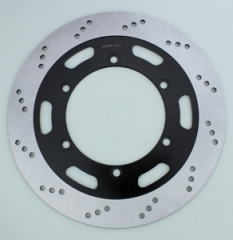
|
Ningbo Imake Industry & Trade co.,LTD
|
TRIUMPH THUNDERBIRD
| Payment Terms: | T/T,L/C |
| Place of Origin: | Zhejiang, China (Mainland) |
|
|
|
| Add to My Favorites | |
| HiSupplier Escrow |
Product Detail
Triumph obtained further lasting publicity with Marlon Brando's 1953 motion picture, The Wild One, in which he rode a 1950 6T Thunderbird.
Product name: excellent front brake disc of TRIUMPH
To capture the American market, the 6T Thunderbird used a variant of the earlier Speed Twin's parallel twin engine, bored out from 500 cc to 650 cc to give the added horsepower American customers demanded.[2] The concept of enlarging the Speed Twin, the Thunderbird name and its 'paper dart' logo were thought up by managing director Edward Turner on one of his regular trips to Triumph's operations in the USA. The 'paper dart' logo was embossed onto the chain case cover on Thunderbirds from 1955 to 1962 and can be seen upon closer examination on the supplied photograph of the 1962 model. Previously, it appeared as a decal on the headlamp nacelle.
To capture the American market, the 6T Thunderbird used a variant of the earlier Speed Twin's parallel twin engine, bored out from 500 cc to 650 cc to give the added horsepower American customers demanded.[2] The concept of enlarging the Speed Twin, the Thunderbird name and its 'paper dart' logo were thought up by managing director Edward Turner on one of his regular trips to Triumph's operations in the USA. The 'paper dart' logo was embossed onto the chain case cover on Thunderbirds from 1955 to 1962 and can be seen upon closer examination on the supplied photograph of the 1962 model. Previously, it appeared as a decal on the headlamp nacelle.
1962 Triumph Thunderbird, the last with the 'pre-unit' engine. Note the nacelle, siamesed exhaust system and the full version of the unpopular bathtub rear fairing.
The 6T Thunderbird was launched publicly at Montlhéry near Paris, where three standard production bikes were ridden around a circuit by a team of riders who between them averaged a speed of 92 mph (148 km/h) over a distance of 500 miles (800 km). All three machines were ridden to the circuit and back to the Meriden factory.
Triumph obtained further lasting publicity with Marlon Brando's 1953 motion picture, The Wild One, in which he rode a 1950 6T Thunderbird. In the book Triumph Motorcycles In America, there is reproduced a letter from Triumph's importers objecting to the producers as to the use of their machine in this film about rowdy motorcycle gangs.
From 1960, the Thunderbird acquired Turner's rear fairing nicknamed the 'bathtub' on account of its shape. This unpopular feature, dropped quickly in the USA market, remained in ever-abbreviated forms for the home market until disappearing altogether for the final year of production, 1966. Before then, in 1963, the Thunderbird, along with Triumph's other 650 cc models, was given the Turner-designed unit engine. Throughout this time, however, the Thunderbird retained it's distinctive nacelle.
Didn't find what you're looking for?
Post Buying Lead or contact
HiSupplier Customer Service Center
for help!










